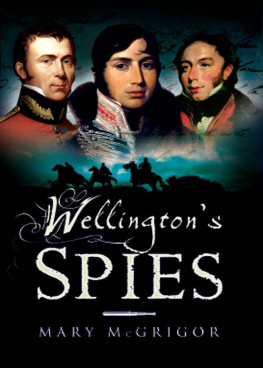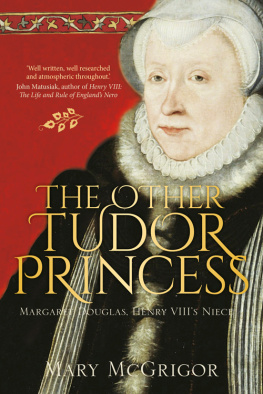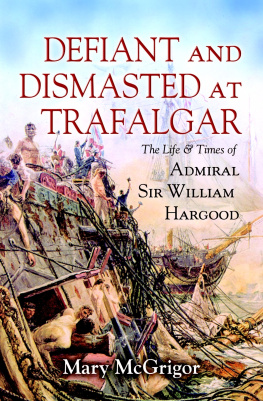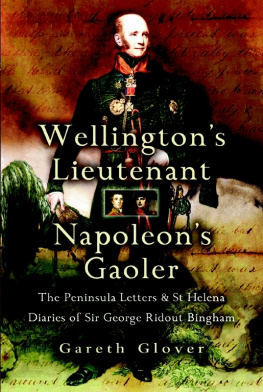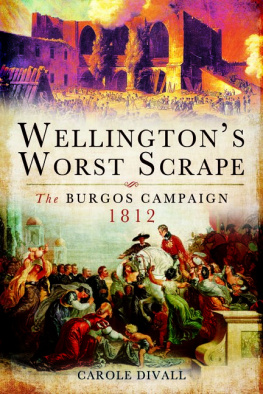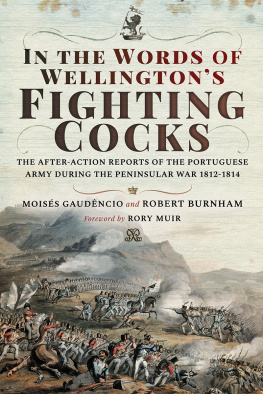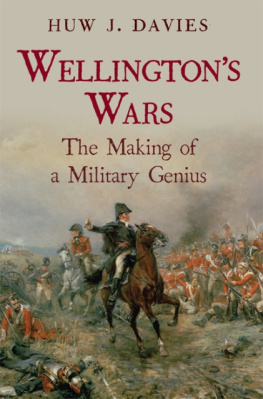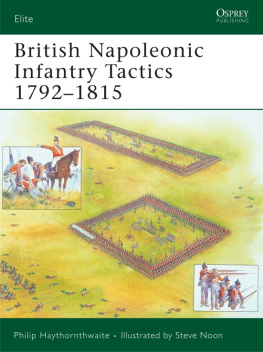WELLINGTONS
SPIES
Other books by Mary McGrigor
History of South Lochaweside
Dalmally and the Glens
Argyll, Land of Blood and Beauty
Grass will not grow on my grave the story of the Appin Murder in 1752
History of the Family of Edmonstone of Duntreath (edited)
The Scalpel and the Sword. Autobiography of Sir James McGrigor, father of the R.A.M.C (edited)
Rob Roys Country
Defiant and Dismasted at Trafalgar

First published in Great Britain in 2005 by
LEO COOPER
an imprint of
Pen & Sword Books Ltd
47 Church Street
Barnsley
South Yorkshire
S70 2AS
Copyright Mary McGrigor, 2005
ISBN 1 84415 328 2
Digital Edition ISBN: 978 1 84468 311 6
The right of Mary McGrigor to be identified as Author of this Work has been asserted by her in accordance with the Copyright, Designs and Patents Act 1988.
A CIP catalogue record for this book is
available from the British Library
All rights reserved. No part of this book may be reproduced or transmitted in any form or by any means, electronic or mechanical including photocopying, recording or by any information storage and retrieval system, without permission from the Publisher in writing.
Typeset in Sabon by
Phoenix Typesetting, Auldgirth, Dumfriesshire
Printed and bound in England by
CPI UK
Pen & Sword Books Ltd incorporates the Imprints of Pen & Sword Aviation, Pen & Sword Maritime, Pen & Sword Military, Wharncliffe Local History, Pen & Sword Select, Pen & Sword Military Classics and Leo Cooper.
For a complete list of Pen & Sword titles please contact
PEN & SWORD BOOKS LIMITED
47 Church Street, Barnsley, South Yorkshire, S70 2AS, England
E-mail:
Website: www.pen-and-sword.co.uk
For my husband, Eddy McGrigor,
Direct descendant of both Edward Charles Somers
Cocks and Colquhoun Grant.
ACKNOWLEDGEMENTS
My deepest thanks must go, firstly, to Julia Page for her great generosity in allowing me to quote from her book Intelligence Officer in the Peninsula, a must for students of Wellingtons campaign. Also to James Hervey Bathurst of Eastnor Castle for information and photographs from the archives of the family of Somers Cocks. To my neighbours John and Julia Keay and Georgina Nelson. To my editor Tom Hartman, to Neil Hyslop, designer of the maps, and most specially to Brigadier Henry Wilson, Publishing Manager of Pen & Sword, and his wonderful team.
Also to the many pople who have helped to find the illustrations: the National Portrait Gallery in London; Shona Corner of the Scottish Portrait Gallery in Edinburgh; Jane Cunningham of the Courtauld Institute in London; Senora Teresa Vargas of the Prado in Madrid; Viscountess Esher for contacting the Prado; and Captain P.H. Starling, Curator of the Army Medical Services Museum in Aldershot. Finally, to my husband Eddy, who did the cooking while I wrote the book!
The line drawings all come from Andrew Leith-Hays own Narrative of the Peninsular War, published in 1831.
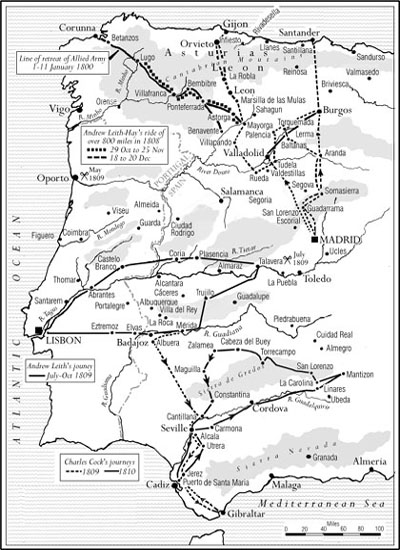
The Journeys of Andrew Leith-Hay and Charles Cocks 18081810

Locations of Allies and French Armies 1810
| January | Wellington on Douro French army centred on Mrida General Carlos ODonnell at Villa del Rey and Aliseda. |
| February | French take Caceres Town retaken by Don Carlos Espaa French reoccupy Caceres. |
| March | Large detachment of Spanish army sent to La Roca Don Carlos at Montijo All of Estremadura, north of Guadiana, held by Marques de Romana Andrew Leith-Hay returns to Lisbon Marshal Massena, Prince dEssling, commanding 6th Corps dArme, besieges Ciudad Rodrigo and Almeida. |
| July | 2nd Corps dArme crosses Tagus at Vila Valha, marches on Castelo Branco, then through mountains towards Guarda 2 July French cross frontier of Portugal and take fortress of Ciudad Rodrigo. |
| August | French take Almeida. |
| September | Advance of 2nd Corps dArme towards Guarda and Celorico. 8th Corps march on Pinhel Wellington orders Hill and Leith-Hay to march towards River Mondego 27 September Battle of Busaco. |
| October | British army withdraws to lines of Torres Vedras. |

Journey of Andrew Leith-Hay JanuaryJune 1813
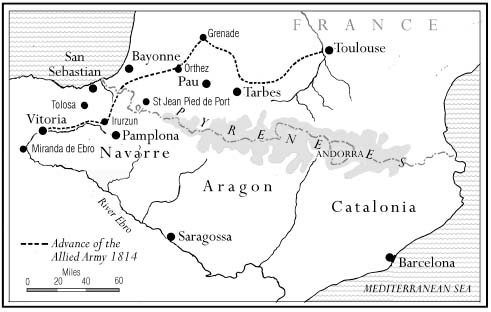
The Final Battles 181314
INTRODUCTION
Intelligence officers, more commonly known as spies, have a special place in history if only for the risks that they run. James Bond, 007, the invention of Ian Fleming, is now a household name. Suave, charming and handsome, he survived fictional hazards, in some instances hardly more amazing than those of three of his predecessors during the Peninsular War.
Foremost amongst those who served in Wellingtons army, were three men, two of them Scotsmen, the third English. Strikingly different in character, they each left first-hand accounts, as did the doctor, another Scotsman, whose journal supplements the tale.
Andrew Leith-Hay, born in 1785, came from Aberdeenshire. His name is accounted for by the fact that his father, Alexander Leith, had inherited the estate of Rannes, from a relative, Andrew Hay, for which reason he had both added the name of Hay to his own and called his eldest son Andrew.
Commissioned as an ensign in the 72nd Foot in 1806, Andrew went to the Peninsula in 1808 as aide-de-camp to his uncle, General Sir James Leith. In this capacity he spent much time in gaining intelligence. Employed by the army to illustrate locations, when cameras were still unknown, he made sketches of both landscapes and towns which, in 1831, he worked up into two volumes entitled Narrative of the Peninsular War. His keen eye for detail is revealed, not only in his sketches, but also in his written descriptions.
Loquacious and sometimes inclined to be pompous, he took himself so seriously that he was a perfect butt for the French who loved to ridicule the British. Nonetheless, thanks to his sense of humour, he saw the funny side of several ludicrous situations which gave his enemies much mirth.
Colquhoun Grant, who like Andrew came from the north-east of Scotland, was quiet and exceedingly reserved. Born at Forres, in Morayshire, in 1770, he was fifteen years older than Andrew and hardened to campaigning before ever reaching the Peninsular. He was known to be extremely clever, having amongst other things, a quick ear for languages which he mastered remarkably well.
Charles Cocks, the scion of a noble family- his father was the second Lord Somers- was born with the proverbial silver spoon in his mouth. Tall and handsome, with all the advantages of wealth, which could have led to a political career, he was nonetheless single minded in his ambition to be a soldier and to reach the heights of his profession. Impetuous and courageous, to the point where he courted danger, he long seemed to bear a charmed life.
From the accounts of these three men, the aspect of each one unique, one can sense the impact of the fighting, the terrible losses both from battle and disease. Yet through the blood and turmoil, the beauty of the country, like sunshine filtering through mist, reaches the readers mind. Orchards, redolent of orange blossom: the magnificent trees of the forests: water foaming white through dark ravines: boats on the great rivers: the rain, the snow, the wind and the suffocating dust, smothering soldiers and horses below a scorching sun.
Next page
